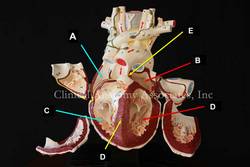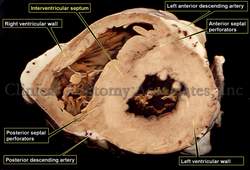|
UPDATED: The prefix [inter-] means "between". The root term [ventricul-] refers to a ventricle, from the Latin [ventriculus], meaning "little sac" or "little belly". The word [septum] is Latin, and means "wall", "division", or "partition". The plural form for [septum] is [septa].
There are two septa in the heart. The interatrial septum (see superior image, item "E") is found between the atria, and the interventricular septum (see superior image, item "D"). The interventricular septum has two components, the muscular interventricular septum, and a small, superiorly situated membranous septum. The interventricular septum is quite muscular as seen in both images. Click on each image for a larger picture.
The cardiac interventricular septum receives blood supply from branches of both the right and left coronary arteries. The anterior 2/3rds of the interventricular septum receive blood supply through anterior septal perforators that arise from the left anterior descending artery (LAD), a branch of the left coronary arteryartery. The posterior 1/3rd of the interventricular septum receives blood supply by way of posterior septal perforators that arise from the posterior descending artery (PDA), a branch of the right coronary artery.
For a detail of the blood supply to the interventricular septum, click on the inferior image.
|
|




